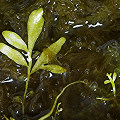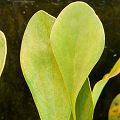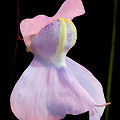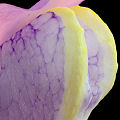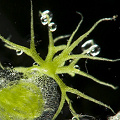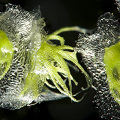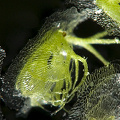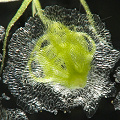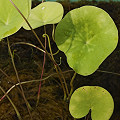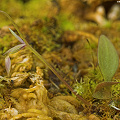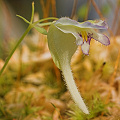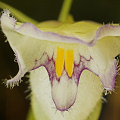| Utricularia section Orchidioides | ||
|---|---|---|
| Species | Range | Habit1 |
| U. alpina2 | Antilles, n South America | T/E |
| U. asplundii2 | Colombia, Ecuador, Venezuela | T/E |
| U. buntingiana2 | n Venezuela | E |
| U. campbelliana2 | Venezuela, Guyana (& n Brazil?) | E |
| U. cornigera | Brazil | T/EA |
| U. endresii2 | Costa Rica, Panama, Colombia, Ecuador | E |
| U. geminiloba2 | Brazil | T/L |
| U. humboldtii | Venezuela, Guyana, n Brazil | E/EA |
| U. jamesoniana2 | Central America, Antilles, South America | E |
| U. nelumbifolia | Brazil | E/EA |
| U. nephrophylla | Brazil | T/L/EA |
| U. praetermissa2 | Nicaragua, Costa Rica, Panama | T/E |
| U. quelchii2 | Venezuela, Guyana, n Brazil | T/E |
| U. reniformis | Brazil | T/EA |
| U. unifolia2 | Central America, w South America | T/E |
|
1T=terrestrial; E=epiphyte; L=lithophyte; EA=emergent aquatic. 2A tuberous species. |
||
Q: About Utricularia subgenus Utricularia section Orchidioides
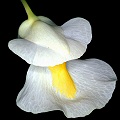
U. alpina
A: With this section, we discuss some of the most spectacular species in the genus. The plants in
section Orchidioides are the celebrities of the genus Utricularia;
other than a very few exceptions (like U. longifolia or U. floridana),
no other species can boast such large leaves or spectacular flowers. Oh the
flowers... Truly they are marvels using any criterion! Yes, the flowers of most Utricularia
are beautiful, but they must be examined closely to be appreciated. Not so for species of this section. They really
knock your socks off!
However, size comes with a cost. These plants, sometimes called the "orchid-flowering" or
"epiphytic" Utricularia, can be very picky. Some like it surprisingly cool (especially those
from tepuis), others like to be subjected to
periods of desiccation (especially the true epiphytes). They survive
these periods by subsisting on the water stored in large tubers. In terms of
cultivation, refer to my discussion on
growing epiphytic and emergent Utricularia.
Until recently, some of these species were classified in a separate section called Iperua, but these
two sections (the old Orchidioides and Iperua) were not
monophyletic, and so were joined. Do not worry if you are confused by issues related to
monophyly and paraphyly; many scientists are equally confused
about this, and just pretend otherwise.
There are only differences between my treatment of this section, and the treatment by Ellison & Adamec (2018)....
1) In a strange move, they include U. humboldtii f. albiflora Komiya & C.Shibata.
If we started including names at the forma level for white flowers....damn, this list would explode in size!
2) They include Utricularia uxoris, which I treat as U. jamesoniana.
3) They include Utricularia uniflora here, as a duplicate entry. It has no business being here at all!
Utricularia alpina
This is a tuberous species. It is fitting that this is the first in my
alphabetical listing, since it is generally considered the easiest of the tuberous species
to grow. If you are unable to coerce this species to thrive, do not waste your time or money on the others.
Utricularia asplundii
To my eyes, this one of the less attractive species in this group. My
complaint is that the calyx lobes are really large compared to the corolla. Granted, the flower
is relatively huge when compared to the flowers other species in the genus, but when you live in section
Orchidioides, you are held to a higher standard! It is relatively easy to grow.
Utricularia buntingiana
This species has only been seen and collected a few times. Its large flower
dwarfs the rest of the plant.
Utricularia cornigera
This species was recently separated from
Utricularia reniformis. It is known to horticulturists as Utricularia
'Big Sister.' It has big leaves, and flowers with a pair of vertical orange lines. There are some who think this might be a
hybrid (Utricularia reniformis×nelumbifolia).
Utricularia humboldtii
One of the relatively easily grown species from the group. This species has
two kinds of leaves. The aerial leaves have long petioles and are paddle-shaped and very leathery. The other leaves are
aquatic, and are divided into several lobes. It has the largest flowers, and just about the largest bladders and leaves too,
of the whole genus. It lives in the urns of large bromeliads (although it can live in other suitably moist sites), including
those of the carnivorous Brocchinia species. From time to
time, it produces long arcing shoots that apparently seek out new places to live. A fabulous species.
Something really cool about this (and related) species is that when the seeds are mature, they are clear, glassy, and flattened.
They look like chips of glass, and you can see the embedded, green seedling inside. When moistened, the seed bursts, and the seedling
crawls out of the seed. The entire germination process takes about seven hours. It is amazing to watch, and you cannot help but
think that you are watching a plant hatch, instead of germinate!
If you have seeds from this plant, you should keep them moist. Research I have done on seed storage for this plant indicates that the
best way to keep the seeds viable is in plastic bags, in your refrigerator.
Utricularia jamesoniana
This is fairly tricky to grow. Part of the problem is that it is exceedingly
tiny, so make sure you do not grow this in live Sphagnum, as moss will overtake it. The
spur of this flower is relatively huge. A true epiphyte, it grows on the trunks of mossy trees.
I still do not accept the name U. uxoris--the only difference
being that U. uxoris has a lower lip that is not as deeply divided as in U. jamesoniana.
Utricularia nelumbifolia
One of the marvels of the genus, this species has peltate leaves that
can become gigantic---about 10cm in diameter. This plant apparently only grows in the urns and leaf axils of bromeliads
(Vriesia species).
Utricularia nephrophylla
This is one of the beginner's plants from this section. It can be grown
easily like a tropical species and it will perform well in this condition. Its tiny little kidney-shaped leaves are
darling.
Utricularia quelchii
This spectacular species shares with U. campbelliana
and U. menziesii
the distinction of being a red-flowered Utricularia. It often grows in the leaf axils of
Brocchinia.
Utricularia reniformis
Think of this as an upscale version of U. nephrophylla;
in fact the two can sometimes be difficult to tell apart when not in flower. A common form in cultivation is
called U. reniformis 'Enfant Terrible,' which
produces both tiny and medium-sized leaves. The vertical lines on the flower are yellow, bordered in white.
Large plants, formerly identified as this species, have been split to
Utricularia cornigera.
Utricularia uxoris
This species is very similar to U. jamesoniana, the only difference
being that this species has a lower lip that is not as deeply divided as in U. jamesoniana.
Utricularia quelchii × praetermissa 'Jitka'
A nice hybrid with very pretty flowers that have
shades of pink, orange, and yellow.
Page citations: Gómez-Laurito, J. 2005; Rice, B.A. 2006a; Studnicka, 2009; Taylor, P. 1989; personal observations.
